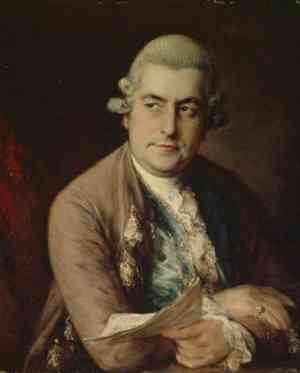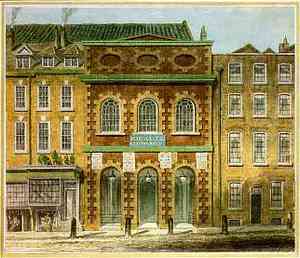


Johann Christian Bach
Painting: Thomas Gainsborough 1776
Source: Wikipedia
Born in Leipzig, Germany, on 5 Sep 1735, Johann Christian Bach was a member of the Bach musical dynasty, one of the major of the lesser. His father, Johann Sebastian Bach, died when Johann Christian, his youngest son, was fifteen. His brother, Carl Philipp Emanuel Bach, was 21 years his senior. Johann was popular in breaking away from baroque form via composing in a freer "galant" style which would arrive to the classical. Just as baroque had emerged in a movement against complex yet stultifying renaissance polyphony to get back to the essential musical part of composing without a lot of tricks, so had baroque come to much the same end now above a century since its development in Italy about 1600. The baroque had brought opera with its humanistic emphasis on Greek song, and musical notation to ensure a steady measure of basso continuo across a musical staff. But by the time JC was born it was running out methods, inevitable that music should leak away from form. Albeit J.C. was definitely a late baroque composer, he also cared not what was baroque, making him galant, which itself would find shape and structure in the classical, ultimately in Mozart.
The galant period was contemporary with the Sturm und Drang ('Storm and Stress') movement in literature arriving to its height during the seventeen seventies as it prepared the way to the Romantic. The galant and classical were the 18th century bridge from the Baroque to the Romantic era of the 19th century. The fortepiano had spent that entire period slowly evolving from part harpsichord toward the grand instrument essential to Beethoven. The bulk of John Christian's keyboard works were likely meant for mainstay harpsichord, though he wrote specifically for piano as well. Perhaps he considered the instrument with which he was acquainted so early as the sixties in England sufficiently developed to specify harpsichord or piano as optional on some works. I hazard to believe, however, that at that early phase he more intended harpsichord, pianoforte if you would for a wealthy court at which amateurs would play the latest possible model. As well, the pianoforte may have been appropriate to chamber at the time, but with a symphony in a large hall or outdoors probably not so much as harpsichord. By this time composers could well endorse the pianoforte as a "promising" instrument, yet stuck to the old tech harpsichord for the all around tried and true work horse.
Of the more than ninety symphonies ascribed to John Christian only 48 have been confirmed. An industrious composer, he otherwise wrote a lot of keyboard and chamber music (sonatas and quartets). He composed a good number of concertos and concertantes for orchestra as well. Concertantes are concertos lite, emphasizing instrumental solos. Johann also authored a good number of canzonettas (light songs originating in Italy in the prior century), arias, liturgical pieces and incidental music.
The verseichnis for Christian Bach is 'The Collected Works of Johann Christian Bach' prepared by Ernest Warburton and published by Garland Publishing in 48 volumes from 1984 to 1999. This a thematic rather then chronological directory which commences with keyboard sonatas W A1 through W A31. Chamber works begin as W B1, orchestral works as W C1, and so forth. Oratorios are W D. Liturgical works are cataloged as W E1 through W E28. Other sacred works are W F. Operas begin at W G1, arias at W H1. Arrangements of works by other composers are W L. Spurious works receive W Y designations. Along with signifying "W" numbers, the Warburton directory also organizes opuses: 'Keyboard Sonata in B flat major' which opens the catalogue as W A1 is also No.1 of Op 5 published as 'Six Sonatas for the Piano Forte or Harpsichord' in 1765 [IMSLP]. Bach's Op 1 (which is not his first work) is 'Six Concertos pour la Clavecin' (harpsichord) published in London in 1763.
Johann Christian no doubt received musical instruction from his father as a child, but in 1756 he went to Italy to study under Giovanni Battista Martini in Bologna as well. In 1760 he became a church organist in Milan, also dropping Luther for Catholicism about that time. He premiered his initial opera, 'Artaserse' W G1, in Turin in 1760 followed by his more famous 'Catone in Utica' W G2 in Naples in 1761.
'Gloria' W E4 G minor Hymn set by Johann Christian Bach
Premiere 19 March 1760 in Milan
Choeur de chambre de Namur / L'ensemble Les Agrémens / Wieland Kuijken
Johann visited London in 1762 to produce operas at the King's Theatre like Handel before him. King's Theatre was the venue at which to perform in England. Below is a drawing of the theatre as it would have appeared in Bach's time, before it burned down in 1789 toward reconstruction in 1791. King's Theatre had first been erected in 1705 as Her Majesty's Theatre (Queen's Theatre), its name changing per gender of the monarch.

Her (His) Majesty's Theatre
(Queen's Theatre / King's Theatre)
Source: Wikipedia
'Zanaida' W G5 Opera by Johann Christian Bach
Premiere 3 May 1763 at the King's Theatre in London
Libretto: Giovanni Gualberto Bottarelli
Opera Fuoco / David Stern
John Christian soon became music master to Sophia Charlotte of Mecklenburg-Strelitz, wife of King George III. In the meantime he met Mozart in London in 1764 when the latter was eight years old. Bach tutored Mozart for about five months, the latter owning a good esteem of Johann's music. Mozart found nice things to say about any musician, but in John's case he was sincere, arranging three of the latter's sonatas into concertos.
'Keyboard Sonata' W A1 B-flat major in 2 movements Johann Christian Bach
No.1 of Op 5: 'Six Sonatas for the Piano Forte or Harpsichord'
Piano: Harald Hoeren
Bach's 'Symphony in G minor' Op 6 No.6 is a flush example of tempestuous 'Sturm und Drang', another way of thinking about counterpoint.
'Symphony' W C12 G minor in 3 movements Johann Christian Bach
No.6 of Op 6 pub 1770
Concerto Koln at the Conservatoire in Brussels 22 Feb 2010
'Sextet' W B78 C major Johann Christian Bach
C 1775 for oboe / 2 horns / violin / cello / keyboard Pub 1783
Berliner Barock-Compagney
'Lucio Silla' W G9 Opera by Johann Christian Bach
Premiere in Mannheim 5 Nov 1775 Libretto: Giovanni de Gamerra
Mozarteumorchester Salzburg / Ivor Bolton
'Amadis de Gaule' W G39 Final opera by Johann Christian Bach
Premiere 14 Dec 1779 at the Académie Royale de Musique in Paris
Libretto:
Philippe Quinault from Alphonse de Vismes (1684) from Garci Rodríguez de Montalvo (1508)
Solamente Naturali / Musica Florea / Didier Talpain
Another of the figures in Bach's life was of little positive value, Johann having the misfortune of employing a steward who stole the majority of his wealth, such that he died in debt in London on New Year's Day in 1782. Charlotte paid his debts and put his widow, Cecilia Grassi (wed 1776), on a pension.
Sources & References for Johann Christian Bach:
Aryeh Oron (Bach Cantatas)
VF History (notes)
Audio of J.C. Bach:
Bach Musical Dynasty:
Bach Cantatas Jochen Grob HOASM Wikipedia Wikisource
Bach Musical Dynasty at VF History / HMR Project (chronological by birth):
Johann Christoph Bach (18 Dec 1642 - 31 March 1703)
Johann Michael Bach (19 August 1648 - 27 May 1694)
Johann Ludwig Bach (14 Feb 1677 - 1 May 1731)
Johann Sebastian Bach (31 March 1685 - 28 July 1750)
Wilhelm Friedemann Bach (22 Nov 1710 - 1 July 1784)
Carl Philipp Emanuel Bach (8 March 1714 - 14 Dec 1788)
Johann Christoph Friedrich Bach (21 June 1732 - 26 January 1795)
Johann Christian Bach (5 Sep 1735 - 1 January 1782)
Compositions / Works:
All Music Bach Digital Klassika RYM
Ernest Warburton / The Collected Works of Johann Christian Bach / 1984 to 1999:
MUSE Music Brainz ReciClassiCat Stanford University Wikipedia English
Recordings of Bach: Catalogs: Discogs
Scores / Sheet Music:
Gallica (digital copies)
IMSLP
(digital copies)
Internet Archive
(digital copies)
Musicalics
(vendor)
Editions:
The Collected Works of Johann Christian Bach / Ernest Warburton / Garland Publishing / 1984-99)
Further Reading:
Tom Service (J.C. Bach's Symphony in G minor Op 6 No.6)
Authority Search: BMLO
BNF Data Deutschen Nationalbibliothek VIAFOther Profiles:
Philadelphia Chamber Music Society
Philharmonia Baroque Orchestra & Chorale
Classical Main Menu Modern Recording
|
|
hmrproject (at) aol (dot) com